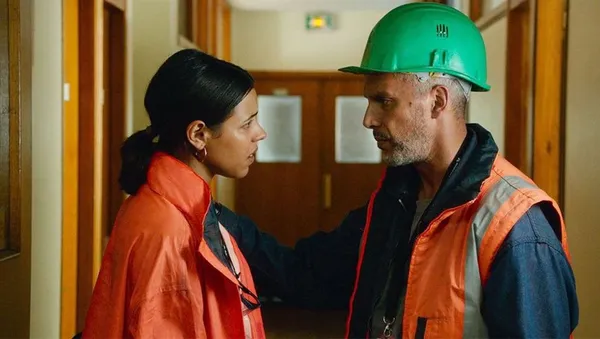 |
| Zita Hanrot and Sami Bouajila in Farid Bentoumi’s toxic Red Soil (Rouge) |
During the 2021 UniFrance and Film at Lincoln Center’s Rendez-Vous with French Cinema there were two virtual live panels. How Music Makes the Film (with composers Jean-Benoît Dunckel of François Ozon’s Summer Of 85; Evgueni Galperine of Fanny Liatard and Jérémy Trouilh’s Gagarine; Nicolas Weil and Sylvain Ohrel of Charlène Favier’s Slalom; Aska Matsumiya (ASKA) of Crystal Moselle’s Skate Kitchen, and Emilie Levienaise-Farrouch of Sarah Gavron’s Rocks).
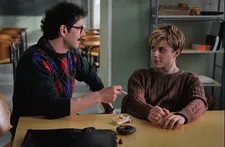 |
| Melvil Poupaud and Benjamin Voisin in François Ozon’s cool Summer Of 85 (Eté 85) |
The Vive la Résistance panel had directors Farid Bentoumi on his Red Soil (Rouge); Reinaldo Marcus Green on Monsters And Men; Kitty Green on The Assistant, and Fanny Liatard and Jérémy Trouilh, moderated by Maddie Whittle.
At the César Awards on March 12, Filippo Meneghetti’s Oscar-shortlisted Two Of Us (Deux), starring Barbara Sukowa and Martine Chevallier won Best First Feature Film. Laure Calamy bested the two of them to win Best Actress for her wildly amusing performance with Patrick in Caroline Vignal’s My Donkey, My Lover And I (Antoinette Dans Les Cévennes). Another Oscar-shortlisted film was honoured when Thomas Vinterberg’s Another Round, starring Mads Mikkelsen, took home the Best Foreign Film César. Emilie Dequenne won Best Supporting Actress in Emmanuel Mouret’s Love Affair(s). It was the only win for the film that had received a record 13 nominations. François Ozon’s Summer Of 85 was shut out in the 12 categories that his film had been nominated.
During the Zoom webinar I sent in the following comment and question, which Maddie extended to address the other panelists as well, about their aesthetic choices to go with the respective subject matter.
Anne-Katrin Titze: Farid, you show so well how the toxins are also sinking into the personal interactions. Visually we see a poisonous wound hidden in the forest. Can you talk about how you worked on combining the two?
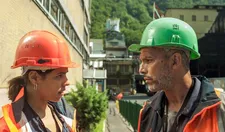 |
| Farid Bentoumi: “There is this factory in the south of France, they really have this toxic waste. It’s red and it’s huge and it’s hidden.” |
Maddie Whittle: And more broadly, I would just ask each of you how you wove the narrative into the aesthetic of the film and how you created a visual language or sort of spacial language for showing these dynamics and these conflicts?
Farid Bentoumi: I built the image of the movie around two things: We’re more and more inside the factory and more and more the movie ends down in the basement of the factory in this tunnel. And we’re more and more into the red colour. There’s no red colour in clothes or in any sets, in any apartments, nowhere. The only red colour is when she [Nour played by Zita Hanrot] goes to the wedding of her sister [Sofia, Alka Balbir] and there’s this big fight with her father [Slimane, Sami Bouajila]. That’s when the truth comes out. That’s when she spits the truth like that to her father. And then there’s more and more and more red dust in the factory and at first we don’t see it. When she first visits the factory it’s very light, we don’t really see it. It becomes more and more red until she goes in nature and in this forest we see this lake - actually, it’s all visual effects. It’s not real. It was a beautiful lake in the French Alps, actually. It’s all fake. But since it’s based on a true story, it really exists actually. There is this factory in the south of France, they really have this toxic waste. It’s red and it’s huge and it’s hidden. There are roads all around. It’s on a hill like that and there’s a hole in the hill. There are roads all around and you can’t see it. It’s really well done. Nobody can see it. So I tried to do the same thing, nobody can see it. It’s a red dot like that in the middle of a forest. Yeah, I think that’s why. Does it answer the question?
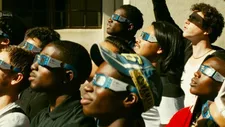 |
| Fanny Liatard: “For Gagarine, it was a challenge for us to find the right balance between magic and realism.” |
AKT (via Chat): Yes it does, thank you!
Fanny Liatard: For Gagarine, it was a challenge for us to find the right balance between magic and realism. So we wanted the film to go into space but we decided to start in a very living [housing] block and the dynamics inside there. And the space is just the imagination, just the passion of a teenager and nothing else. He has posters in his room. To find a coherence we decided to always see the scenes always through the eyes of Youri [Alseni Bathily], the character. So the passion for space is just in his room and then little by little he’s more and more isolated in this building and the imagination is going out his head and spreading into the building. So we go with the image but also with the sound we go more and more into space until we finish completely into the cosmos. The colours also were important for us because all his daily life is in blue and green and when Youri is dreaming and when his dreams are taking over the place, it’s becoming red. So the movie is getting red also but not in the same way.
Reinaldo Marcus Green: I would just say for Monsters and Men, it’s a film about perspective, so obviously it’s a triptych in its form. Originally it was more constructed like [Alejandro González Iñárritu’s] Amores Perros. I love that film and I really tried to like page by page make the connections and I failed. So we ended up having a slightly more siloed structure and I used another film, Elephant by Gus Van Sant, as a way. I found the camera work in that film and how they moved from character to character was really interesting to me. How you can all be connected in the same place but also just continue to move.
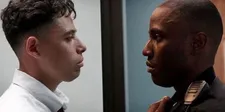 |
| Reinaldo Marcus Green: “I would just say for Monsters And Men, it’s a film about perspective, so obviously it’s a triptych in its form.” |
"The language of the film that was obviously very self-contained in one school and I thought, could you do that in a neighbourhood? So I sort of combined my passion for those two movies and tried to come up with a visual language for how I would transition from one story to the next story, trying to make them feel connected by a neighbourhood but also making them feel distinct in their perspective. That’s how my failed attempt at making a bad version of Crash ended up becoming what you see as the structure of our film.
Kitty Green: I was very limited by the setting. We were in an office building; it’s grey walls, grey carpet, fluorescent light. There wasn’t much we could really do visually. There’s only so much we could do with the lighting. We tried to reference Fincher and Zodiac and these kind of gloomy office spaces. But anything that didn’t seem like an authentic office lighting setup was false. So what we leaned on really heavily was the sound. Actually, you, Reinaldo, mentioned Elephant. The soundtrack of Elephant is one of the best soundtracks, there’s barely any music. It’s built up of environmental sound in a really beautiful way. So I tracked down that sound designer, who’s Leslie Shatz, and we got him involved to do the same thing with The Assistant where he went out and recorded sirens and beeps and hums and whistles. So we could create tension really with these sounds you hear every day. Those are really mundane sounds but you can pitch them up in frequency or volume and really play with them in order to give us what we needed. It’s a bit of everything really, trying to balance it so that it could feel authentic but also we could heighten it when we needed and play around.
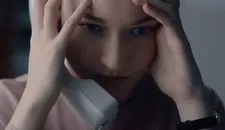 |
| Kitty Green on The Assistant: “What we leaned on really heavily was the sound.” |
Film at Lincoln Center Talks are presented by HBO.
How Music Makes the Film was organized in partnership with French In Motion, SACEM, and The Gotham Film and Media Institute.
The 26th edition of Rendez-Vous with French Cinema, organized by Film at Lincoln Center’s Florence Almozini and Madeline Whittle with UniFrance, will run through March 17 on Film at Lincoln Center Virtual Cinema.
Oscar nominations will be announced on Monday, March 15, 2021. The Academy of Motion Picture Arts and Sciences (AMPAS), will honour the best films released between January 1, 2020, and February 28, 2021.





















